QoS Priority-Based Mobile Personal Cell Deployment with Load Balancing for Interference Reduction between Users on Coexisting Public Safety and Railway LTE Networks
Abstract
1. Introduction
1.1. Related Work
1.2. Motivations
1.3. Main Contributions
- We deploy mPCs under coexisting environments of public safety networks (PS-LTE and LTE-R) to assess the proposed scenario’s performance.
- We propose a QoS_mPCD scheme for load balancing and interference reduction that can associate users wisely during a cell range extension (CRE) offset to an mPC according to their connection priority levels, as mentioned in Table 1.
- Since high-priority users can be offloaded to the mPC, we thus employ an eICIC scheme to further decrease interference with the mPC’s offloaded users.
- Unlike fixed small cells, the dynamic ratio of the almost blank sub-frame (ABS) muting ratio is considered in this paper [13].
- Sine LTE-R is assumed to be the train control signal, zero error tolerance is needed for reliable communications. Therefore, we provide the best resources to the LTE-R user during the resource allocation process.
- We evaluate important performance indexes (throughput, interference, and outage).
2. System Methodology for Coexisting Public Safety Networks
2.1. Priority Gates Model of the PS-LTE Network
2.2. Details of the Network Layout
2.3. Details of the Channel Model
3. Proposed QoS_mPCD Scheme Procedure
| Algorithm 1. Proposed QoS priority-based mPC deployment scheme |
| 1: For each BS j ∈ B 2: Initialization 3: 3. BS (K ∈ 11) ← (BS[PS =3, R = 8])) 3: parameters (i, SINR_threshold, cellEdgeUE, cellCenterUE, LTE RUE, PS UE, mPC UE, HII). 4: Step 1. Context Information Collection 5: Exchange the context information between UE and BS. 6: Count the number of cell-edge users based on SINR threshold. 7: for each UE u ∈ U do 8: Check SINRu,j < SINR_thresholdu,j 9: uedge = uedge + 1 10: end for 11: Users (PS-LTE UE, LTE-R UE, mPC UE) are classified based on priority. 12: Step 2. User Association and Resource Allocation 13: for each UE u ∈ U do 14: Estimate PLu,j and select BS j that maximizes and associates user u with it. 15: Allocate maximum transmission power to users. 16: if SINRLTE-R,j < SINR_thresholdLTE-R,j 17: Use distance-based power control scheme for users to meet LTE-R UE SINR. 18: end if 19: Dynamically adjust RBs during the RBs allocation for mPC user. 20: end for 21: Calculate the load on each BS j. 22. Compute Throughput, Received SINR, and Interference on each UE u, respectively. 23: i = i + 1 24: Step 3. Application of SDN-based eICIC 25: while HII = 0 26: for each M ∈ B in 1st-tier do 27: Use optimum ABS ratio to accordingly transmit ABS. 28: Plan offloaded users’ u in mPC during ABS. 29: end for 30: end while |
3.1. Step 1: Context-Information Collection
3.2. Step 2: User Association and Resource Allocation
3.3. Step 3: Application of SDN-Based eICIC
4. System-Level Simulation
Simulation Results and Discussion
5. Conclusions
Author Contributions
Funding
Conflicts of Interest
References
- Ahmad, I.; Chang, K. Mission-critical user priority-based cooperative resource allocation schemes for multi-layer next-generation public safety networks. Phys. Commun. 2020, 38, 100926. [Google Scholar] [CrossRef]
- Ahmad, I.; Chen, W.; Chang, K. LTE-Railway User Priority-Based Cooperative Resource Allocation Schemes for Coexisting Public Safety and Railway Networks. IEEE Access 2017, 5, 7985–8000. [Google Scholar] [CrossRef]
- Chen, W.; Ahmad, I.; Chang, K. Co-channel interference management using eICIC/FeICIC with coordinated scheduling for the coexistence of PS-LTE and LTE-R networks. EURASIP J. Wirel. Commun. Netw. 2017, 2017, 1–14. [Google Scholar] [CrossRef]
- Jang, J.; Chang, K. Integrated Public Safety Network. In KICS Information and Communication Magazine-Open Lecture Series; 15–18 December 2017; pp. 32–43. [Google Scholar]
- Jang, J.; Chang, K. QoS for public safety network services, establish priorities and share RAN policies. In Proceedings of the KICS Conference, Jeoungseon, Korea, 21–24 January 2018; pp. 776–777. [Google Scholar]
- Ye, Q.; Rong, B.; Chen, Y.; Al-Shalash, M.; Caramanis, C.; Andrews, J.G. User Association for Load Balancing in Heterogeneous Cellular Networks. IEEE Trans. Wirel. Commun. 2013, 12, 2706–2716. [Google Scholar] [CrossRef]
- Abderrazak, J.B.; Zemzem, A.; Besbes, H. QoS-driven user association for load balancing and interference management in HetNets. In Proceedings of the 6th Int. Conf. Netw. Future (NOF), Montreal, QC, Canada, 30 September–2 October 2015; pp. 1–3. [Google Scholar]
- Das, S.K.; Sen, S.K.; Jayaram, R. A dynamic load balancing strategy for channel assignment using selective borrowing in cellular mobile environment. Wirel. Netw. 1997, 3, 333–347. [Google Scholar] [CrossRef]
- Kaleem, Z.; Hui, B.; Chang, K. QoS priority-based dynamic frequency band allocation algorithm for load balancing and interference avoidance in 3GPP LTE HetNet. EURASIP J. Wirel. Commun. Netw. 2014, 2014, 185. [Google Scholar] [CrossRef]
- Bejerano, Y.; Han, S.-J. Cell breathing techniques for load balancing in wireless LANs. IEEE Trans. Mobile Comput. 2009, 8, 735–749. [Google Scholar] [CrossRef]
- Le, L.B.; Hossain, E.; Niyato, D.; Kim, D.I. Mobility-aware admission control with QoS guarantees in OFDMA femtocell networks. In Proceedings of the 2013 IEEE International Conference on Communications (ICC), Budapest, Hungary, 9–13 June 2013; pp. 2217–2222. [Google Scholar]
- Singh, S.; Andrews, J.G. Rate distribution in heterogeneous cellular networks with resource partitioning and offloading. In Proceedings of the 2013 IEEE Global Communications Conference (GLOBECOM), Atlanta, GA, USA, 9–13 December 2013; Volume V13.1, pp. 3796–3801. [Google Scholar]
- Kaleem, Z.; Chang, K. Public Safety Priority-Based User Association for Load Balancing and Interference Reduction in PS-LTE Systems. IEEE Access 2016, 4, 9775–9785. [Google Scholar] [CrossRef]
- Kim, S. Bargaining Solution-Based Resource Allocation Scheme for Cloud-Assisted Wireless Body Area Networks. Wirel. Commun. Mob. Comput. 2020, 2020, 1–10. [Google Scholar] [CrossRef]
- Wang, J.; Rouil, R.A.; Cintron, F.J. Distributed resource allocation schemes for out-of-coverage D2D communication. In Proceedings of the 2019 IEEE Global Communications Conference (GLOBECOM), Waikoloa, HI, USA, 9–13 December 2019; pp. 1–5. [Google Scholar]
- Qureshi, M.; Fayaz, M.; Mashwani, W.K.; Belhaouari, S.B.; Hassan, S.; Shah, A. A comparative analysis of resource allocation schemes for real-time services in high-performance computing systems. Int. J. Distrib. Sens. Netw. 2020, 16, 1–35. [Google Scholar] [CrossRef]
- Karthiban, K.; Raj, J.S. An efficient green computing fair resource allocation in cloud computing using modified deep reinforcement learning algorithm. J. Soft Comput. 2020, 24, 14933–14942. [Google Scholar] [CrossRef]
- Wang, J.; Song, X.; Ma, Y. A novel resource allocation scheme in NOMA-based cellular network with D2D communication. Future Internet 2020, 12, 1–22. [Google Scholar] [CrossRef]
- Kaleem, Z.; Li, Y.; Chang, K.H. Architecture and features for 5G mobile personal cell. In Proceedings of the International Conference on Information and Communication Technology Convergence, Jeju, Korea, 28–30 October 2015; pp. 164–166. [Google Scholar]
- NPSTC Broadband Working Group-Priority; QoS Task Group. Priority and QoS in the Nationwide Public Safety Broadband Network; Rev1.0; National Public Safety Telecommunications Council: Centennial, CO, USA, April 2012. [Google Scholar]
- Service Accessibility Version 16.4.0, Document 3GPP TS 22.011. 2018. Available online: https://itectec.com/archive/3gpp-specification-ts-22-011/ (accessed on 1 November 2012).
- Netmanias Technology Document, LTE QoS–SDF vs. EPS Bearer; Netmanias: Seattle, WA, USA, 2012.
- Jeffrey, G.A.; Stefano, B.; Wan, C.; Stephen, V.H.; Angel, L.; Anthony, C.K.; Jianzhong, C.Z. What will 5G be? IEEE J. Sel. Areas Commun. 2014, 32, 1065–1082. [Google Scholar]
- Public Safety Broadband high-Power User Equipment (UE), 3GPP TR 36.837 v 11. 2012. Available online: https://itectec.com/archive/3gpp-specification-tr-36-837/ (accessed on 1 November 2012).
- Claussen, H.; Green, S. Efficient modelling of channel maps with correlated shadow fading in mobile radio systems. In Proceedings of the IEEE International Symposium on Personal, Indoor and Mobile Radio Communications, Berlin, Germany, 11–14 September 2005; pp. 512–516. [Google Scholar]
- Radio Frequency (RF) System Scenarios, 3GPP TR 36.942 v12.0. 2014. Available online: https://www.etsi.org/deliver/etsi_tr/136900_136999/136942/12.00.00_60/tr_136942v120000p.pdf (accessed on 1 November 2012).
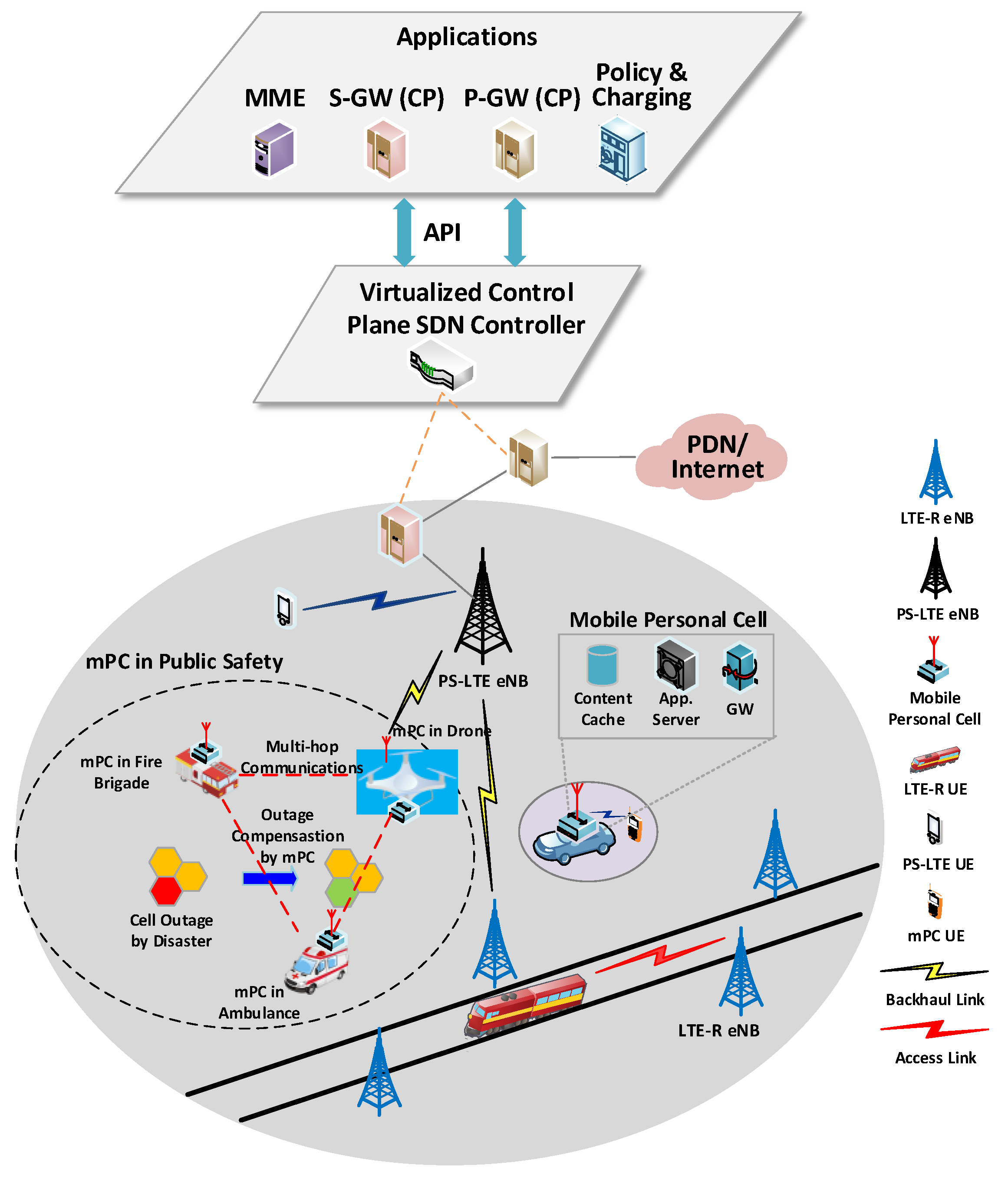
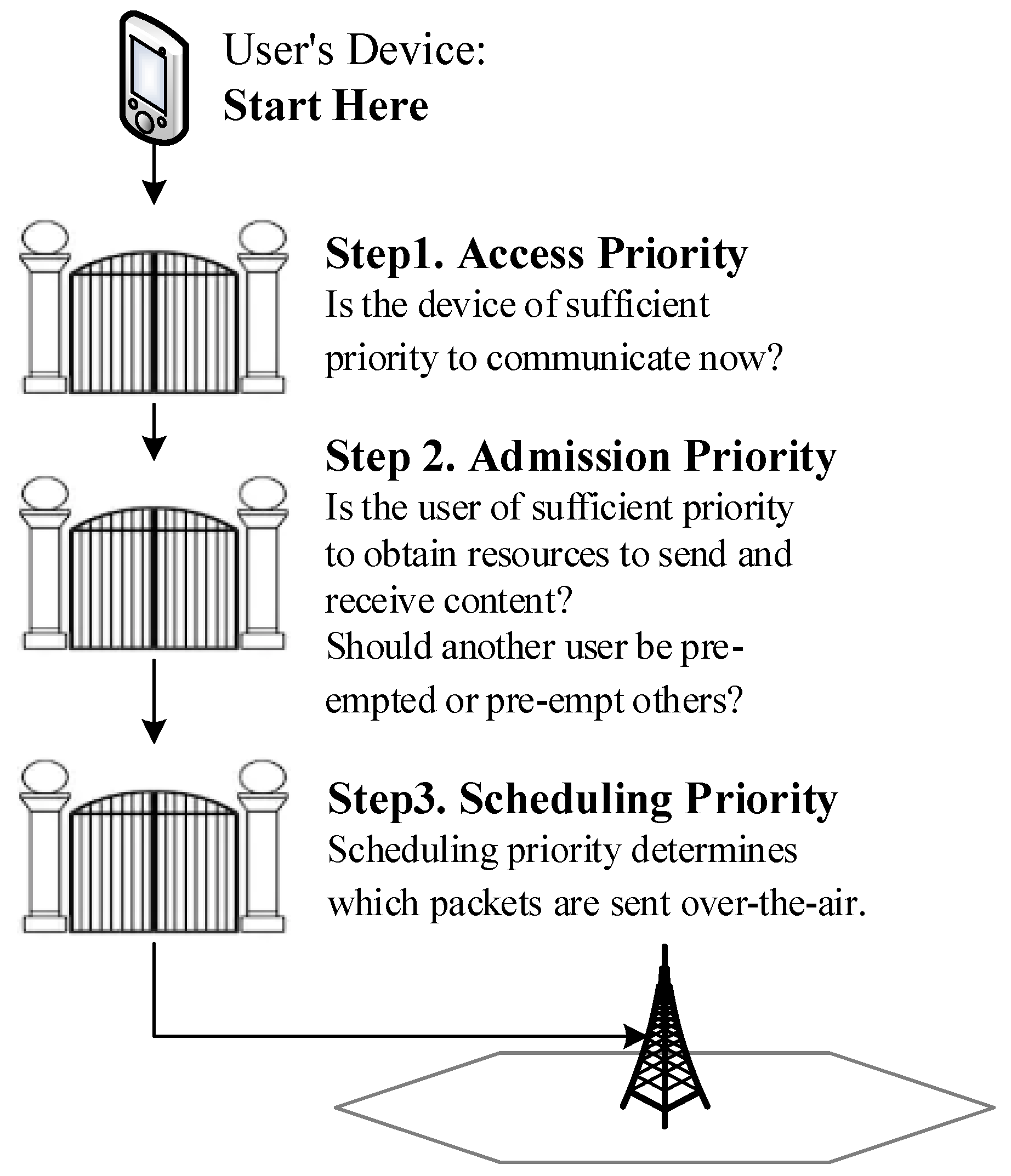
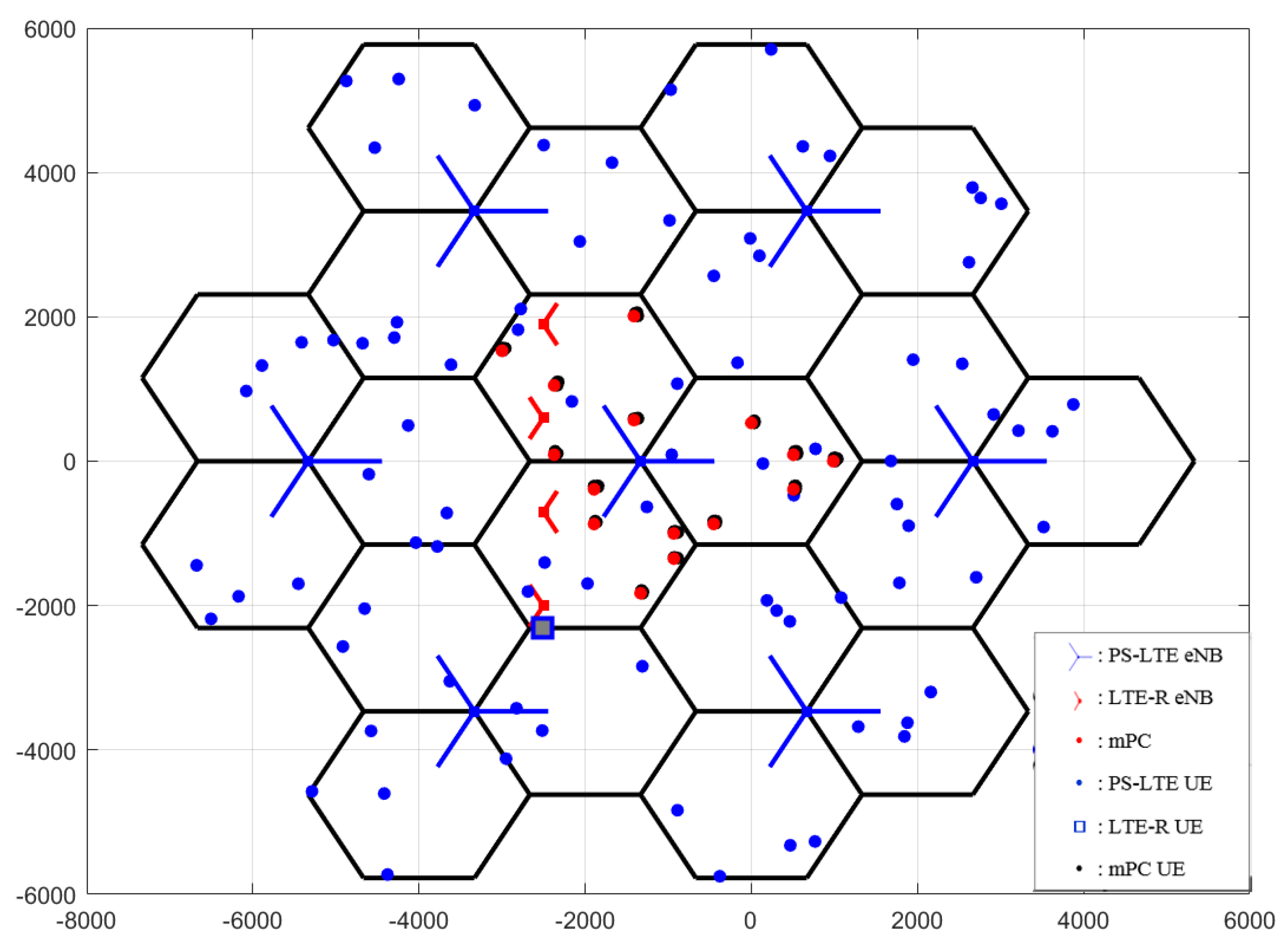
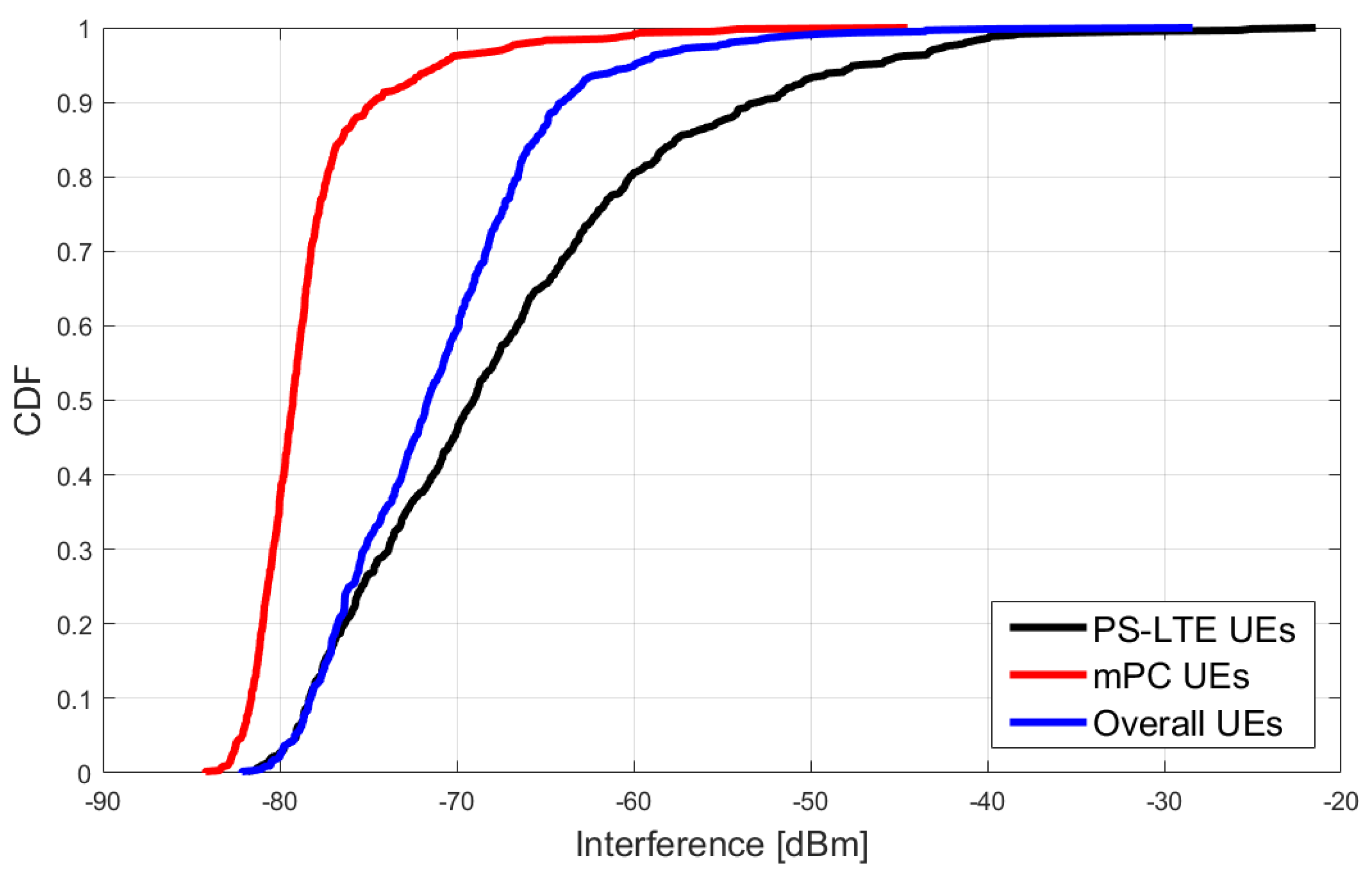
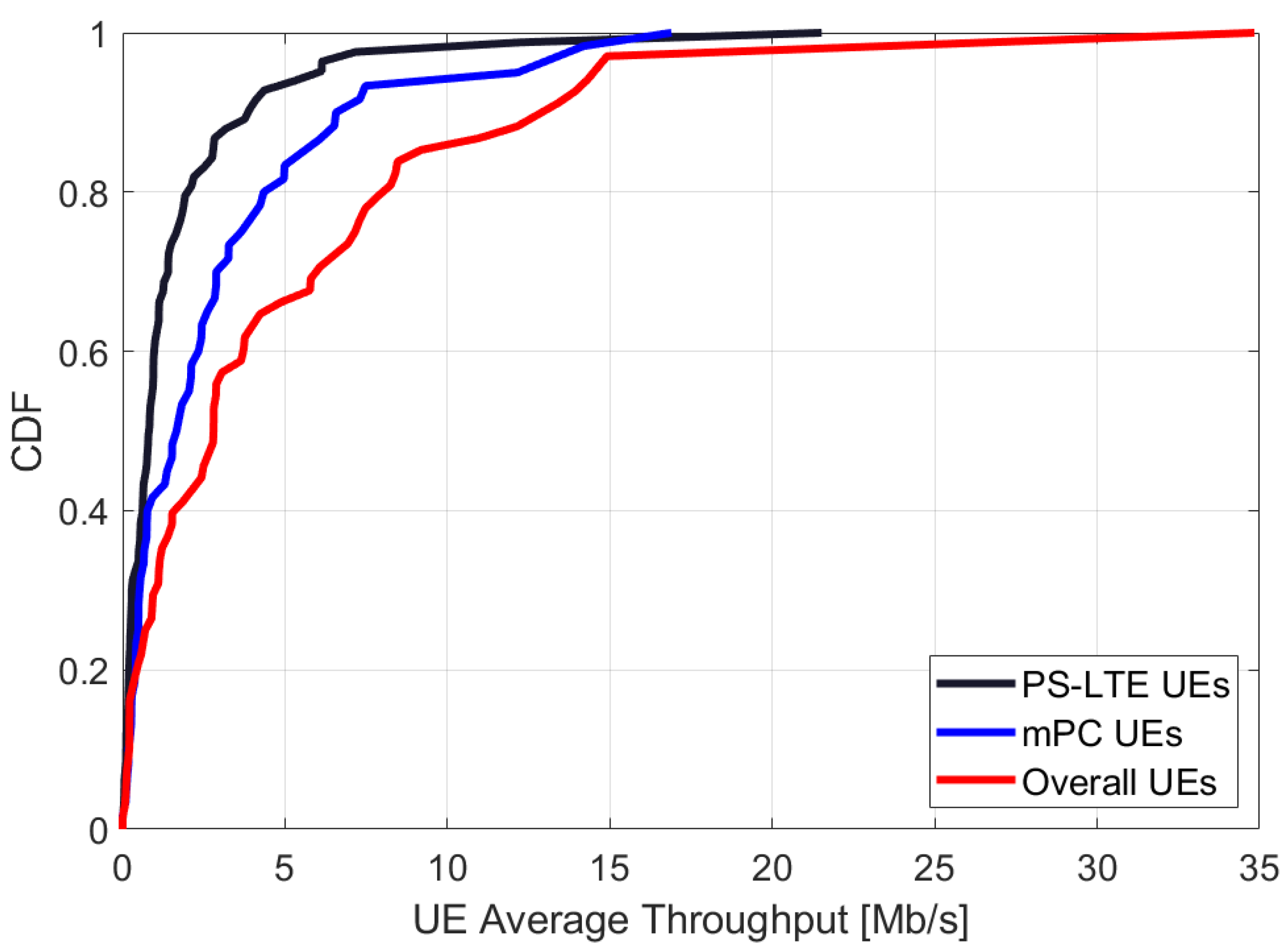
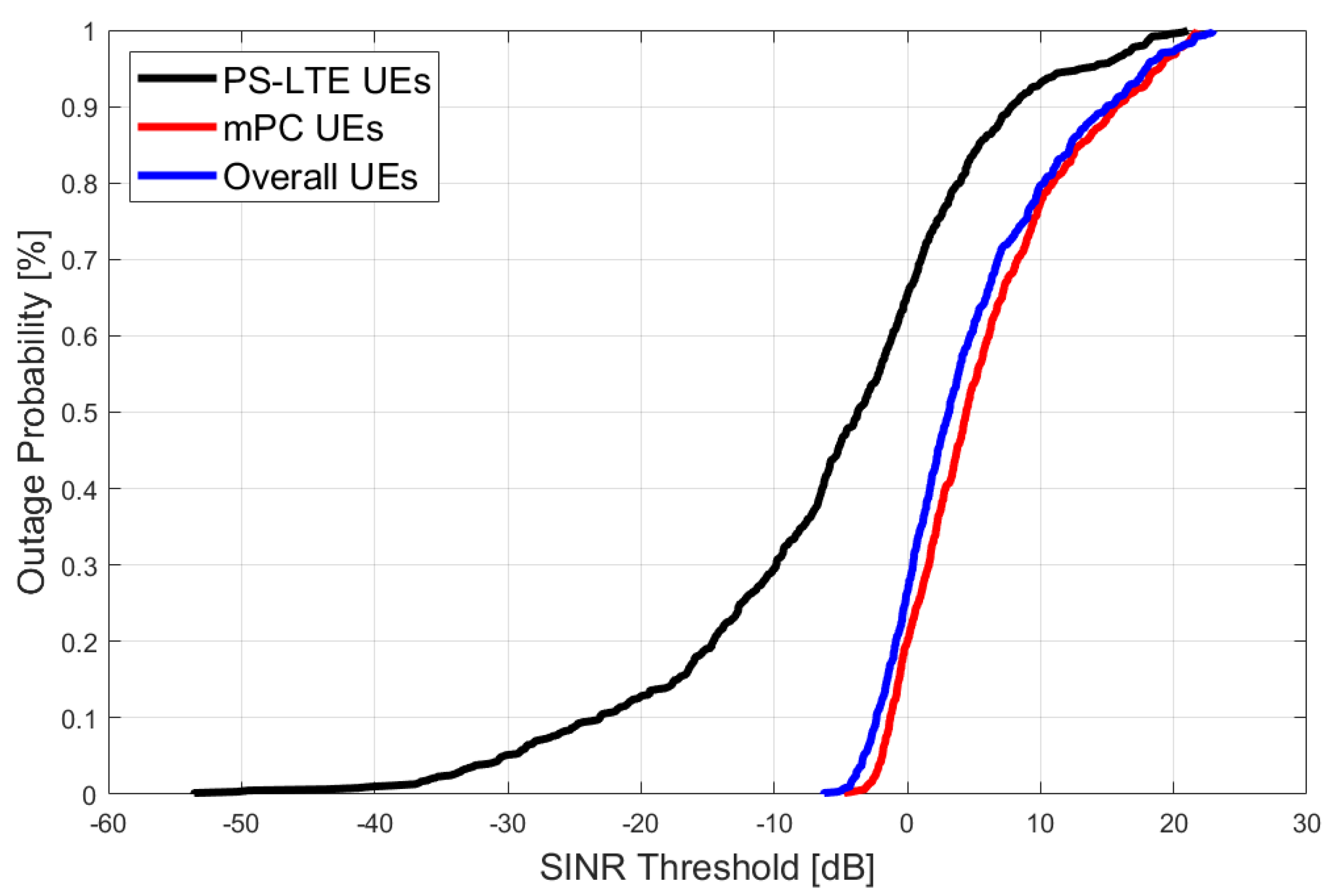
| User Priority | User Identification | Traffic Class | Barring (RACH) | Establishment Cause |
|---|---|---|---|---|
| PS First Responders | PS Emergency: PS1 to PS5 | 12–14 | Barring for Special | High-priority Access |
| Commercial User Emergency | Commercial User Emergency | 10 | Barring for Special | Emergency |
| Commercial User Non-Emergency | Commercial User Non-Emergency | 0–9 | Low Barring Factor | Mobile originating |
| Traffic Model | ARP | QCI | QCI Priority | ||
|---|---|---|---|---|---|
| Preemption Capability | Preemption Vulnerability | ||||
| LTE-R | Control Data | Yes | No | 0 | 1 |
| PS-LTE | Voice Call | Yes | Yes | 1 | 2 |
| Parameter | Value |
|---|---|
| Carrier Frequency | 723 MHz |
| System Bandwidth, No. of PRBs | 10 MHz uplink, 50 PRBs |
| No. of PS-LTE eNBs | 21 Sectors (1-tier, 7 Sites) [Only 3 Inner Sectors in the ROI] |
| No. of LTE-R eNBs | Maximum 2 eNBs/Sector beside the Railway |
| Inter-eNB Distance | PS-LTE eNBs: 4 km / LTE-R eNBs: 1 km |
| No. of mPCs | 21 mPCs/Inner Sector in the ROI |
| mPC Mobility Pattern, Speed | mPC Random Walking Model, 3km/h |
| No. of UEs/Sector | mPC UEs: 4/mPC / PS-LTE UEs: 8 LTE-R UEs: 1 (Control Signal) |
| UE Mobility | LTE-R UEs: 250 km/h |
| UE RF Parameters | Max Tx Power: 23 dBm / Noise Figure: 9 dB |
| Path Loss Model | Rural Macro (3GPP TR 36.837) |
| Shadowing | Log-normal Distribution (Mean: 0 dB, SD: 6 dB) |
| Fast Fading | mPC: Winner Ⅱ (D1-Rural Macro) LTE-R: Winner Ⅱ (D2a-Rural Macro) |
| MCS | MCS 0 ~ MCS 28 |
| Transmission Mode | SISO (1 × 1) |
| Thermal Noise Density | 174 dBm/Hz |
| Scheduling | Proportional Fair Traffic |
Publisher’s Note: MDPI stays neutral with regard to jurisdictional claims in published maps and institutional affiliations. |
© 2020 by the authors. Licensee MDPI, Basel, Switzerland. This article is an open access article distributed under the terms and conditions of the Creative Commons Attribution (CC BY) license (http://creativecommons.org/licenses/by/4.0/).
Share and Cite
Ahmad, I.; Jang, J.; Chang, K. QoS Priority-Based Mobile Personal Cell Deployment with Load Balancing for Interference Reduction between Users on Coexisting Public Safety and Railway LTE Networks. Electronics 2020, 9, 2136. https://doi.org/10.3390/electronics9122136
Ahmad I, Jang J, Chang K. QoS Priority-Based Mobile Personal Cell Deployment with Load Balancing for Interference Reduction between Users on Coexisting Public Safety and Railway LTE Networks. Electronics. 2020; 9(12):2136. https://doi.org/10.3390/electronics9122136
Chicago/Turabian StyleAhmad, Ishtiaq, JinYoung Jang, and KyungHi Chang. 2020. "QoS Priority-Based Mobile Personal Cell Deployment with Load Balancing for Interference Reduction between Users on Coexisting Public Safety and Railway LTE Networks" Electronics 9, no. 12: 2136. https://doi.org/10.3390/electronics9122136
APA StyleAhmad, I., Jang, J., & Chang, K. (2020). QoS Priority-Based Mobile Personal Cell Deployment with Load Balancing for Interference Reduction between Users on Coexisting Public Safety and Railway LTE Networks. Electronics, 9(12), 2136. https://doi.org/10.3390/electronics9122136






